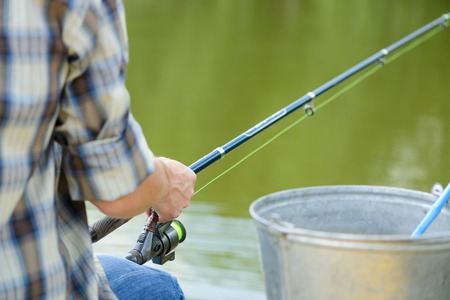1. Understanding the Basics of Fishing Line
If youre just getting into fishing, one of the first things you’ll need to learn about is the fishing line. It might look like just a simple string, but it plays a huge role in your success out on the water. Choosing the right type of line can make all the difference between landing that big catch or going home empty-handed.
What Is a Fishing Line?
A fishing line is the cord that connects your bait or lure to your fishing rod and reel. It’s designed to be strong enough to handle the weight and fight of a fish, yet thin enough to stay unnoticed in the water. There are different materials and types, each suited for specific fishing styles and conditions.
How Does a Fishing Line Work?
The line carries your hook and bait into the water and transmits movement and tension back to your rod when a fish bites. A good fishing line should be strong, flexible, and durable enough to handle friction from water, rocks, or even the fish’s teeth without breaking easily.
Why Choosing the Right Fishing Line Matters
Not all fishing lines are created equal. The right line helps you cast farther, feel bites better, and land fish more successfully. Picking the wrong one could lead to tangles, poor casting, or even losing your catch. Here’s a quick comparison of the three most common types of fishing lines:
| Type | Material | Main Features | Best For |
|---|---|---|---|
| Monofilament | Nylon | Stretchy, affordable, easy to use | Beginners, general-purpose fishing |
| Braided | Woven fibers | Strong, thin diameter, no stretch | Heavy cover, deep water, experienced anglers |
| Fluorocarbon | Polyvinylidene fluoride | Nearly invisible underwater, abrasion-resistant | Clear water, finesse techniques |
Quick Tip:
If youre just starting out, monofilament is often the best choice because its forgiving and easy to manage. As you get more comfortable with fishing techniques and local conditions, you can explore other types based on your needs.
Remember:
Your fishing line is one of the most important tools in your tackle box. Understanding its basics will help you make better choices and enjoy more success every time you head out on the water.
2. Different Types of Fishing Line Explained
When youre just starting out with fishing, picking the right fishing line can feel overwhelming. But don’t worry — it’s not as complicated as it seems. There are three main types of fishing lines you’ll want to get familiar with: monofilament, fluorocarbon, and braided. Each type has its own strengths, and knowing when to use each one can help you catch more fish and have a better time on the water.
Monofilament Line
Monofilament (or “mono”) is the most beginner-friendly type of fishing line. It’s made from a single strand of nylon, which makes it affordable, easy to handle, and forgiving for newbies learning how to cast or tie knots.
Best For:
- Pond or lake fishing
- Small to medium freshwater species like bass, trout, or panfish
- Topwater lures because mono floats
Pros:
- Inexpensive
- Easy to knot
- Good stretch helps absorb shock
Cons:
- Not as strong as other lines at the same diameter
- Prone to UV damage over time
- More visible in clear water
Fluorocarbon Line
Fluorocarbon is similar in appearance to monofilament but offers some key advantages. It’s nearly invisible underwater, making it ideal for clear water conditions where fish are easily spooked.
Best For:
- Clear lakes and rivers
- Finesse techniques like drop shotting or jigging
- Fish that are line-shy (like trout or pressured bass)
Pros:
- Low visibility underwater
- Abrasion-resistant for rocky areas or heavy cover
- Sinks faster than mono — good for deep presentations
Cons:
- Tends to be stiffer and harder to manage for beginners
- More expensive than mono
- Can be tricky when tying knots if youre new to fishing
Braided Line
Braided line is made by weaving together several strands of synthetic fiber. It’s super strong for its diameter and has almost zero stretch, giving you excellent sensitivity — great for feeling light bites.
Best For:
- Heavy cover like thick weeds or brush piles
- Larger fish species like pike, muskie, or saltwater game fish
- Casting long distances or deep water fishing
Pros:
- Extremely strong and durable
- Sensitive — helps detect subtle bites fast
- Casts farther due to thin diameter
Cons:
- Easily visible in clear water — often needs a fluorocarbon leader
- Tougher on rod guides if not matched properly
- Knot tying can be tricky for beginners without practice
Quick Comparison Table:
| Line Type | Main Benefits | Best Used In |
|---|---|---|
| Monofilament (Mono) | Affordable, easy to use, good stretch | Ponds/lakes, topwater lures, small-medium freshwater fish |
| Fluorocarbon (Fluoro) | Low visibility, abrasion resistance | Clear water, finesse techniques, spooky fish |
| Braided Line (Braid) | High strength, low stretch, long casts | Heavy cover, big fish, deep or long-distance casting |
The right fishing line depends on where youre fishing and what kind of fish youre going after. As a beginner, starting with monofilament is usually your best bet while you build up your skills. Later on, you can try fluorocarbon or braid as you explore different fishing situations.

3. Line Strength and Pound Test: What It Means
When youre just starting out with fishing, one of the most important things to understand is line strength—often referred to as “pound test.” This number tells you how much weight a fishing line can handle before it breaks. It’s usually printed right on the spool of line, like 6 lb, 10 lb, or 20 lb test. But what does that actually mean for your time on the water?
What Is Pound Test?
The pound test rating is a guideline that tells you how strong your fishing line is. For example, a 10-pound test line is designed to hold up to 10 pounds of pressure before it might snap. That doesnt mean you can’t catch a fish heavier than that—it just means there’s more risk involved.
Matching Line Strength to Fish Size
Choosing the right pound test depends on the type of fish youre targeting. If youre going after small panfish or trout, a lighter line will do the job. But if youre aiming for bass, catfish, or even saltwater species, youll need something stronger. Here’s a quick reference chart to help you choose:
| Target Fish | Recommended Pound Test | Fishing Environment |
|---|---|---|
| Panfish (Bluegill, Crappie) | 2–6 lb | Lakes, Ponds |
| Trout | 4–8 lb | Streams, Rivers |
| Bass | 8–12 lb | Lakes, Rivers |
| Catfish | 12–20 lb | Lakes, Rivers |
| Pike/Musky | 15–30 lb | Larger Lakes |
| Saltwater Species (Redfish, Snook) | 20–50 lb+ | Bays, Ocean |
The Gear Factor: Rods and Reels Matter Too
Your rod and reel also play a big role in choosing the right pound test. Light spinning reels are designed for lighter lines—usually under 10 lb test—while baitcasting reels can handle heavier lines. Using a line thats too heavy for your setup can lead to poor casting performance or even damage your gear.
A Quick Tip:
If youre not sure where to start, go with a versatile option like an 8–10 lb monofilament line. Its forgiving for beginners and works well for many freshwater species.
Why It Matters
Picking the right pound test helps you land more fish and avoid breaking off during a fight. It also keeps your gear balanced and makes for a smoother fishing experience overall.
Understanding how pound test relates to fish size and your equipment is a key step toward building confidence on the water—and catching more fish!
4. Choosing the Right Line for Your Fishing Style
When it comes to picking the right fishing line, your choice should match how and where you plan to fish. Not all lines are created equal—what works great for freshwater trout may not hold up in saltwater when youre going after redfish or snook. Lets break down how different fishing styles can influence your line selection.
Freshwater vs. Saltwater Fishing
The environment plays a big role in what kind of line you need. Freshwater conditions are generally less harsh, so you can often get away with lighter, more sensitive lines. Saltwater fishing, on the other hand, requires tougher lines that can handle abrasive surfaces and bigger fish.
| Fishing Environment | Recommended Line Type | Why It Works |
|---|---|---|
| Freshwater | Monofilament or Fluorocarbon | Good sensitivity and stretch; ideal for smaller fish |
| Saltwater | Braided or Heavy Fluorocarbon | More strength and abrasion resistance for tough conditions |
Spinning Reels vs. Baitcasting Reels
The type of reel youre using also affects your line choice. Spinning reels are beginner-friendly and work well with lighter lines, while baitcasting reels are better suited for heavier lines and experienced anglers who want more control and casting distance.
| Reel Type | Best Line Option | Key Features |
|---|---|---|
| Spinning Reel | Monofilament or Light Braided Line (10–20 lb test) | Smoother casting; reduced line twist; easy to manage |
| Baitcasting Reel | Braided or Heavier Fluorocarbon (20+ lb test) | Greater strength; better for heavy lures and cover |
Other Factors to Consider
Lure Weight and Target Species
If youre throwing lightweight lures for panfish or crappie, go with a lighter line (4–8 lb test). For bass or catfish, youll need something stronger (12–20 lb test). Big game saltwater fishing? Think even heavier—sometimes up to 80 lb test braided line.
Water Clarity
In clear water, fluorocarbon is a great option because its nearly invisible underwater. In murky or stained water, visibility isn’t as much of an issue, so monofilament or braid will do just fine.
Knot Strength and Ease of Use
If youre new to fishing, monofilament is easier to tie knots with and more forgiving when it comes to mistakes. Braided lines are strong but can be tricky to knot correctly without experience.
Selecting the right fishing line based on your style helps improve your chances out on the water. Whether youre planning a peaceful day at a local lake or heading offshore for something bigger, choosing the right setup makes all the difference.
5. Tips for Storing and Maintaining Your Line
Taking care of your fishing line is just as important as choosing the right one. Proper storage and regular maintenance can help prevent tangles, damage, and wear — all of which can cost you fish and money. Here’s how to keep your line in top shape, especially if youre new to fishing.
Keep It Cool and Dry
Fishing lines, especially monofilament, can weaken when exposed to heat or sunlight over time. Always store your spools in a cool, dry place — think a tackle box kept in the garage or closet, away from direct sunlight or hot car trunks.
Avoid Direct Sunlight
UV rays break down the materials in most fishing lines. When not in use, cover your reels or store them indoors. If you’re on a boat, consider using reel covers or keeping extra spools in shaded compartments.
Use Line Spoolers or Organizers
A line spooler helps keep your fishing line neat and tangle-free while also making re-spooling easier. You can also use simple organizers like zip bags with labels for different types of line (mono, fluoro, braid) and weights.
Example: Simple Storage Tips by Line Type
| Line Type | Storage Tip |
|---|---|
| Monofilament | Store in cool, dark places; replace yearly due to UV damage |
| Braided Line | Keep dry; check for frays regularly |
| Fluorocarbon | Avoid bending; store in original spool to prevent memory issues |
Rinse After Saltwater Use
If youre fishing in saltwater, always rinse your reel and line with fresh water after each trip. Salt can corrode components and weaken the line over time.
Check for Damage Regularly
Before every trip, run your fingers along the first few feet of line coming off the reel. Feel for nicks, frays, or weak spots. If anything feels off, cut that section off or replace the line entirely. Its better than losing a catch due to a snapped line.
Replace Old Line As Needed
No matter how well you store it, fishing line has a shelf life. A good rule of thumb:
| Usage Frequency | When to Replace Your Line |
|---|---|
| Every weekend (frequent) | Every 2–3 months |
| A few times per season (moderate) | Once per season |
| Rarely used gear (occasional) | At least once a year before use |
Label and Date Your Spools
If you have multiple spools of line lying around, label them with the type of line, pound test, and date purchased. This helps you keep track of age and prevents accidental use of old or mismatched line.
Treating your fishing line with care isn’t complicated — it just takes a little attention before and after each outing. These small habits will save you time on the water and help you land more fish in the long run!
6. Common Mistakes Beginners Make with Fishing Line
When youre just getting started with fishing, its easy to overlook some of the finer details—like how important your fishing line really is. Many beginners make the same simple mistakes that can lead to a frustrating day on the water. Here’s a breakdown of the most common missteps and how you can steer clear of them.
Using the Wrong Type of Line
One of the biggest mistakes new anglers make is choosing the wrong type of fishing line for their setup or target species. Each type of line—monofilament, fluorocarbon, and braided—has its pros and cons, and using the wrong one can impact casting, visibility, strength, and overall performance.
| Line Type | Best For | Common Beginner Mistake |
|---|---|---|
| Monofilament | General purpose, easy handling | Overstretching or using in heavy cover where it may break easily |
| Fluorocarbon | Clear water, stealthy presentations | Using it as a mainline when not needed—it’s stiffer and harder to manage |
| Braided | Heavy cover, long casts, strong hooksets | Using without a leader; fish might see it due to lack of invisibility |
Not Checking for Wear and Tear
Your line takes a lot of abuse every time you cast, retrieve, or fight a fish. Rocks, logs, sun exposure, and even just repeated use can weaken it over time. Beginners often forget to inspect their line before and after fishing sessions.
How to Avoid This:
- Check for frays: Run your fingers along the first few feet of line looking for rough spots.
- Replace regularly: If your line looks cloudy or feels brittle, swap it out before your next trip.
- Cut off damaged sections: Don’t be afraid to snip off a few feet if they look worn—that could save your catch.
Poor Knot Tying
Knot failure is another common issue. Even if you’ve got the best gear in the world, a bad knot will ruin your day fast. Beginners often tie knots incorrectly or choose ones that aren’t suited for their line type.
Knot Tips:
- Practice at home: Learn reliable knots like the Improved Clinch Knot for mono or fluorocarbon and the Palomar Knot for braid.
- Wet your knots: Always moisten before tightening to reduce friction and prevent weakening.
- Tighten slowly and evenly: Rushing this step can lead to slippage or breakage under pressure.
Mismatching Line Strength (Pound Test)
The pound test indicates how much weight your line can handle before breaking. A common beginner mistake is using too heavy or too light a line for their rod-reel combo or target fish species.
| Pound Test Range | Recommended Use |
|---|---|
| 2–6 lb | Panfish and trout with ultralight gear |
| 8–12 lb | Bass fishing with medium setups |
| 15–30 lb+ | Larger species like pike, catfish, or saltwater fish |
Poor Storage Habits
If you leave your fishing gear in hot garages or direct sunlight for weeks at a time, your line will suffer. Heat and UV rays can degrade most types of fishing lines over time.
Storage Tips:
- Keep it cool and dry: Store rods and reels indoors away from sunlight when not in use.
- Avoid tangles: Wind your line tightly on spools to prevent memory issues (coiling).
- Date your spools: If you buy bulk line, mark the purchase date so you know when it’s time to replace it.
Avoiding these beginner mistakes will help you get more bites and lose fewer fish—and who doesn’t want that? Taking care of your fishing line is just as important as picking the right lure or finding the perfect spot. With these tips in mind, youll be better prepared each time you hit the water.


